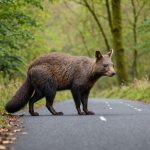Overview of Roadkill Statistics in the UK
Understanding the impact of roadkill on native wildlife populations in the UK offers insight into conservation challenges. Currently, roadkill statistics reveal thousands of animals are affected annually, influencing biodiversity significantly. Native species, such as hedgehogs and badgers, show notable population declines tied to road incidents.
Over the years, historical trends indicate fluctuating roadkill rates. Population shifts in both human and wildlife demographics, alongside increased traffic, contribute to these changes. While some areas report decreases due to effective interventions, other regions experience growing numbers, highlighting regional variation.
Also to see : Must-have plants for uk gardens: key species to support native butterfly habitats
In addressing wildlife impact, UK traffic laws play a crucial role. Laws prioritise wildlife protection, although gaps in enforcement and coverage remain. The legal framework involves measures such as speed limits in vulnerable areas and mandatory reporting of certain wildlife collisions, aimed at reducing harm.
These statistics not only underline the need for more stringent traffic laws but also emphasize the necessity of proactive wildlife conservation efforts. With roadkill numbers serving as an indicator of broader ecological health, developing strategic solutions is pivotal for preserving the UK’s diverse wildlife heritage.
Also read : Unlocking the Benefits of Night-Time Curfews: A Boon for Urban Wildlife in the UK
The Role of Infrastructure in Protecting Wildlife
Ensuring that road infrastructure supports wildlife safety is paramount. Adequate design plays a vital role in mitigating roadkill incidents. For instance, well-planned wildlife crossings enable safe passage for animals across busy highways. These structures vary, including overpasses, underpasses, and culverts, which are strategically placed in known animal migration routes.
The effectiveness of these crossings depends largely on thoughtful design features tailored to specific species’ needs. Overpasses are often planted with local vegetation, helping blend the structure with natural surroundings and encouraging usage by various animal species. Similarly, underpasses are designed to accommodate the behavioural patterns of ground-dwelling creatures.
Collaboration between wildlife organizations and transport agencies ensures that infrastructure solutions are both environmentally friendly and practical. By integrating ecological research into engineering, these partnerships foster innovative approaches to road safety.
Ultimately, enhancing road infrastructure is not just about creating physical barriers but fostering a harmonious coexistence between human development and the natural environment. By prioritising such initiatives, a balance between progress and wildlife preservation can be achieved, leading to sustainable transport networks that respect and protect native wildlife.
Key UK Traffic Laws Addressing Wildlife Protection
In the UK, traffic laws play a significant role in ensuring wildlife protection. Specific regulations focus on reducing roadkill and safeguarding native species. For instance, certain laws mandate speed limits in areas known for high animal activity. These limits help decrease the chances of wildlife collisions by giving drivers additional time to react and animals the chance to safely cross roads.
However, the enforcement of these laws often faces challenges. Limited resources can lead to inconsistent compliance, weakening the intended protective measures. While mandatory reporting of significant wildlife collisions is in place, its implementation varies by region, impacting the reliability of data on roadkill incidents.
Comparatively, some proposed laws aim to enhance current measures. Strengthening enforcement through technology, such as speed cameras in wildlife zones, is under consideration. These improvements could bolster the effectiveness of existing regulations, providing more comprehensive coverage.
Ultimately, addressing enforcement and compliance challenges is critical. Current and future traffic laws must be both practical and rigorously applied to ensure meaningful enhancements in wildlife protection. By refining these legal frameworks, the UK can significantly reduce roadkill and preserve its ecological heritage.
Case Studies of Successful Wildlife Protection Initiatives
Successful wildlife protection initiatives in the UK provide compelling examples of how to effectively reduce roadkill. A standout project is Scotland’s A9 Wildlife ~Project~, which implemented innovative wildlife crossings. This initiative involved constructing overpasses and underpasses along the A9 corridor, resulting in a significant decrease in wildlife collisions.
Local communities and agencies played crucial roles in these initiatives. Public workshops increased awareness and involvement, garnering support for installing wildlife crossings. This collaboration not only facilitated project success but also fostered a sense of shared responsibility for biodiversity protection.
Another example includes the Wildlife Trusts’ signage improvements on rural roads, aimed at alerting drivers about high animal activity areas. Signage designed in collaboration with local councils effectively reduced roadkill incidents, particularly involving hedgehogs and badgers.
Lessons from these successful projects emphasize the importance of strategic infrastructure placement and community involvement. Tailoring design features to local wildlife behaviour enhances effectiveness, while public engagement boosts compliance and community backing. These case studies highlight the need for combining technical innovation with community cooperation for sustainable wildlife protection efforts.
Recommendations for Policy Improvements
Improving wildlife conservation through enhanced policy recommendations requires a multi-faceted approach. One essential step is formulating new traffic regulations focused explicitly on wildlife safety. Implementing mandatory speed limits in wildlife-heavy zones and expanding the use of wildlife crossings can greatly decrease roadkill incidents. Regular assessment and adaptation of existing laws are equally crucial. By continually evaluating the efficacy of current measures, policymakers can modify strategies to address emerging wildlife patterns and traffic changes.
Public awareness campaigns play a substantial role in boosting compliance with these regulations. Educating drivers and communities about the importance of wildlife safety fosters a more conscientious public. These campaigns can highlight the impact of roadkill on biodiversity and the collective responsibility in preventing it. Encouraging proactive participation deepens the community’s commitment to wildlife protection.
Overall, policy improvements should integrate science-based recommendations with public engagement. By instating rules backed by ecological research and fostering public involvement, the UK can enhance the effectiveness of its traffic laws. This dual approach not only protects native wildlife but also nurtures an enduring culture of wildlife conservation.
Tips for Drivers to Help Protect Wildlife
Driving with wildlife safety in mind requires adopting specific road etiquette. Reducing speed in wildlife-prone areas is one of the most effective measures drivers can take. Slowing down provides extra reaction time, helping to prevent roadkill when animals unexpectedly cross roads. Make it a habit to stay vigilant, particularly during dawn and dusk when wildlife is most active.
Incorporating practical tips can significantly decrease the possibility of wildlife collisions:
- Stay Alert: Continuously scan the road sides for animals. Anticipating potential crossings can prevent accidents.
- Use High Beam: When safe, utilise high beams at night to better spot wildlife and enable prompt action.
- Know Hotspots: Familiarise yourself with areas where wildlife traffic is high and adjust driving accordingly.
Participating in community initiatives advocating for responsible driving practices can further enhance safety. Local programmes often organise training for drivers to increase awareness and promote precautionary measures. These community-centric approaches not only improve individual driving conduct but also foster a culture of conservation. By prioritising driver awareness and adapting behaviours, the driving community can actively contribute to protecting wildlife and preserving biodiversity.











